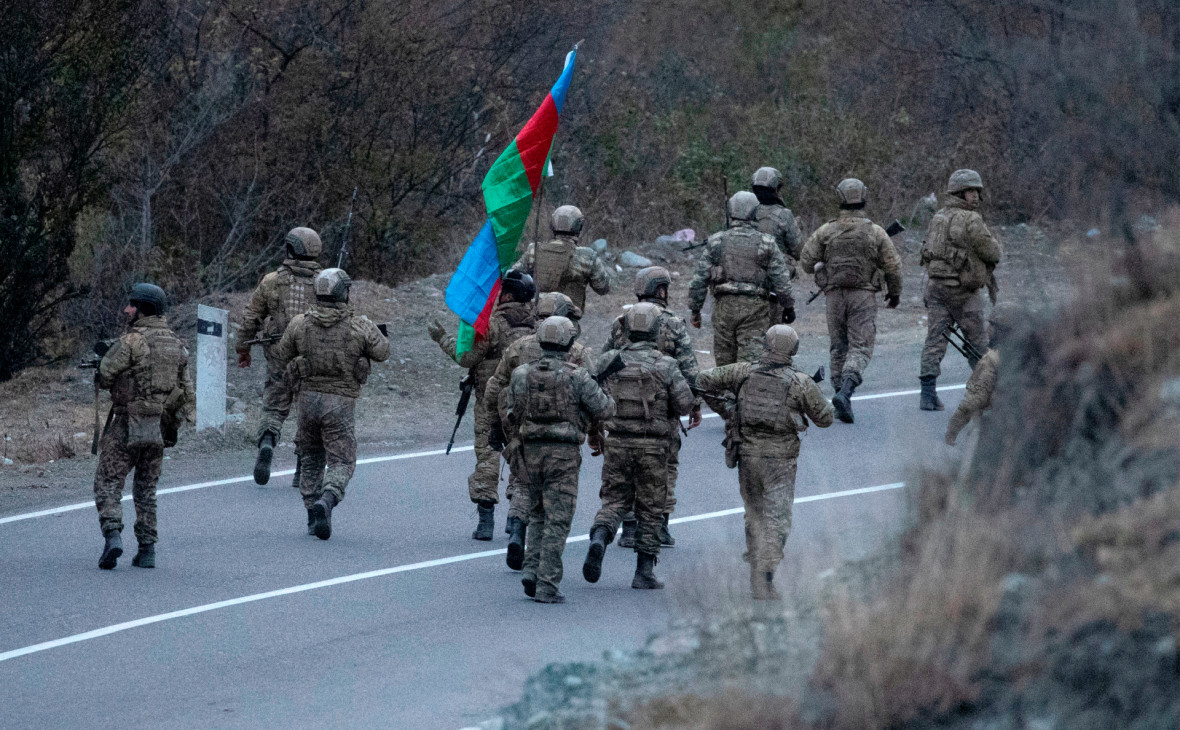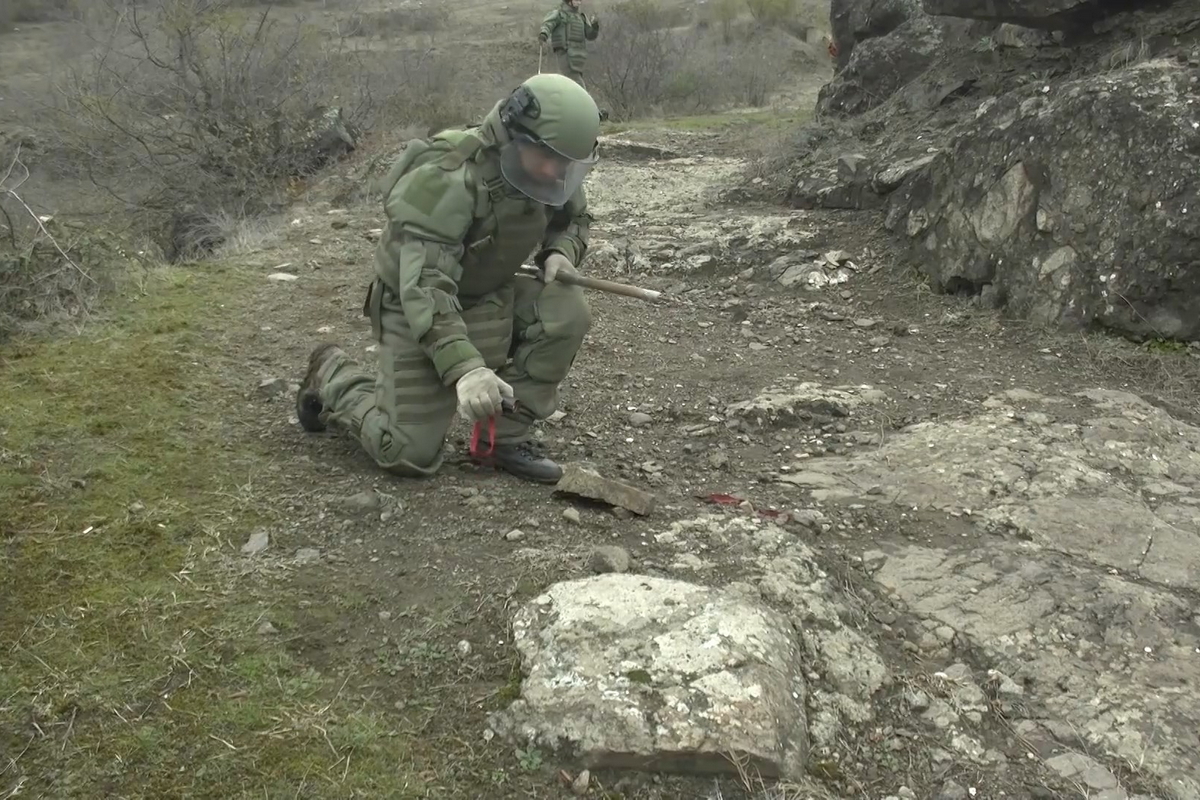Mass protests against Prime Minister Nikol Pashinyan are continuing in Armenia.
People blame him for actually accepting the Azerbaijani conditions for ending the war in Karabakh.
The war in Nagorno-Karabakh, which began early in the morning of September 27, ended 44 days later with the actual defeat of Armenia. In the late night of November 10, Prime Minister Nikol Pashinyan signed an agreement according to which the Armenian side transfers to Azerbaijan the territories it took under its control almost thirty years ago, the territories of seven regions adjacent to the Nagorno-Karabakh Autonomous Region, as well as the cities of Shusha, Hadrut and a number of other villages.
The most intense discussions in Armenia and its diaspora abroad are around the surrender of Shusha. The city is located on the highway connecting Armenia and Nagorno-Karabakh.
The same picture is observed for several kilometers in the direction of Lachin – after Shusha – signs of fighting, heavy one.
It is obvious that the Azerbaijani army carried out a large-scale offensive here and met with resistance along the entire line.
It was after the fall of the strategically important city of Shusha that Yerevan decided that it was no longer able to continue the war.
The disputes over the surrender of Shushi have escalated even more after Russian President Vladimir Putin announced that on October 19-20th, Pashinyan was offered to transfer part of the territory, but at the same time preserve Shusha. The condition was the return to the city of Azerbaijani refugees who left the city in the first war.
Yerevan did not agree to this, because until 1992 Azerbaijanis accounted for up to 90% of the population of Shusha and because it was not clear how to ensure the safety of the Armenians living there.
In addition, according to the agreement, if it had been concluded then, the Azerbaijani refugees would have to return to other Armenian regions of Karabakh, and here the issue of security would also be raised.
On November 7th, forward defensive troops received an order to withdraw from the village of Karin so, lying at the foot of the rock on which Shusha stands, to the city itself. On November 9th, the soldiers were ordered to leave it too – at that time the Azerbaijani troops were already in the city.
The Azerbaijani army marched towards Shusho from the village of Avetaranots.
After that, the attacking group split up: some entered along the road from Karin, the others – from the east through the gorge.
When soldiers were ordered to retreat, many were in the suburbs where the fighting was going on.
According to soldiers who were present, they had no problems with equipment, including night vision devices.
Another thing is ordinary soldiers in positions. In the Martakert direction, absolute darkness falls at night. On the approaches to the trenches with dugouts, covered with a simple tree, they scattered everything that crackles loudly, in the trenches themselves – bundles of empty cans.
This is incredibly poor, and Azerbaijan’s drone usage made the Armenian and Artsakh soldiers exquisitely easy to spot.
Azerbaijan did not have enough strength to hold Shusha for a long time, said Armenian military expert Karen Vrtanesyan.
“If there were normal planning and management of the operation, then in principle it would have been possible to keep or recapture Shusha.”
Due to the landscape, the supply of Azerbaijani troops in the Shusha direction is a difficult task. It was supposed to pass through the village of Avetaranots, and then through the mountains.
Even almost three weeks after the end of the war, Azerbaijan uses a section of the Lachin-Shushi road controlled by the Armenians to supply the city. On this section of the road, there are even cars with both Armenian and Azerbaijani numbers.
“It is completely incomprehensible why this road, which could have been blocked by small forces, was never cut off,” Vrtanesyan said. “Why wasn’t enough force deployed there?”
“You cannot take Shusha, you can only surrender it,” Arsen ascertained. After a pause, he added, as if making excuses: “We are not bad fighters. We were simply handed over.”
According to open data, the armies of Armenia and Nagorno-Karabakh before the start of the conflict lagged behind Azerbaijan in terms of the number of heavy ground equipment, tanks, artillery and manpower. However, this gap cannot be called critical, given that they had to act on the defensive.
According to the reference book of the International Institute for Strategic Studies (IISS) Military Balance for 2019, the number of the NKR defense army totaled 18-20 thousand people. It had about 200-300 T-72 tanks and about the same amount of artillery. The NKR has always been actively supported by the Armenian army, so it is not clear what share of this equipment were Armenian. In 2019, the Armenian army numbered 44 800 people, including conscripts, and had a mobilization reserve of about 220 thousand people. The country had at least 109 tanks. Most of them are T-72, the rest are more ancient. There was also one T-90 which won at Alabino in the 2014 tank biathlon competition.
The number of the Azerbaijani army is 66 950 people (ground forces, air force, navy), the mobilization reserve is about 300,000 people. Baku had at least 439 tanks, of which at least 100 T-90s, but the majority (244 units) were T-72s.
The artillery of Armenia consisted of at least 232 pieces of equipment, including 38 self-propelled guns (122-mm “Carnations” and 152-mm “Acat”), 131 howitzers (based on the D-20 and D-30 cannons, as well as “Hyacinth-B”) and 63 MLRS installations, including 47 Grad and at least six Smerch, as well as several Chinese WM-80s.
Baku, according to the Military Balance, had at least 598 units of artillery equipment, including 96 self-propelled guns (the basis is also made up of Carnations and Acats, but there were also Czech M-77 Dana, as well as Israeli ATMOS 2000), 207 howitzers and MLRS, including more than 60 “Grad”, at least 18 “Solntsepek” and 30 “Smerch”. Also, in service were several Belarusian “Rysy”, “Polonez” and at least 21 “Kasyrga”. There were also Czech RM-70 “Vampir” and Croatian RAC-12.
In addition, at least 16 missile systems were in service with Armenia: eight Elbrus, four Tochka, and four Iskander. Armenia is the only country, apart from Russia, which has Iskanders. Azerbaijan is armed with Tochka missile systems and Israeli LORA operational-tactical missiles.
Obviously using an Iskander ballistic missile was out of the question, unless the situation was much more critical than it was.
Regardless of all of this, the most important element of modern warfare is intelligence, says Vasily Kashin, head of the Center for Comprehensive European and International Studies at the Higher School of Economics. And here was the main advantage of Azerbaijan, the expert is sure:
“You can have parity in the number of artillery units, in heavy ground equipment, tanks, but the potential is determined not by the number of barrels, but by the effectiveness of reconnaissance.” In addition, he adds, the data does not reflect the country’s equipment with modern ammunition: “You have the same MLRS or guns of the Cold War, but one side has modern types of corrected ammunition, and the other does not.”
The role of attack drones like the Bayraktar TB2 in this war is greatly exaggerated, Kashin believes, because the main means of inflicting casualties was artillery, which was helped by reconnaissance. Armenia is the leader in the region in the field of information technology, and in theory it should have had effective technical and cyber intelligence, he says.
“The Azerbaijanis, apparently, were afraid of this and did a great job with social networks and to maintain discipline. But the Armenians clearly had a very poor idea of the location of the Azerbaijani military facilities. This can be seen because even the means of heavy MLRS, which they had, were not used at full range,” the expert explained.
Armenia was ineffective in the area of air defense.
“The entire defense was represented by some kind of separate foci and, moreover, outdated types of equipment like the Wasp,” explains Kashin. – Since the days of the Vietnam War, constant maneuvers and quick withdrawal from positions immediately after firing have become the key to the survival of air defense systems. But, apparently, there was also a problem with the management of those meager forces that the Armenians possessed. On the whole, it seems to me, they did not delve into the experience of armed conflicts in recent decades.”
Baku pursued a much more meaningful procurement policy in the field of weapons, Kashin continued.
“The Armenians had a good potential in the field of creating their own drones and electronic warfare systems. But instead, money was spent on meaningless things – for example, for the purchase of Su-30M, which were not even used in this conflict, and the purchase of several dozen Osa air defense systems from Jordan,” he said.
“As a result, Azerbaijan, whose budget was 3-5 times larger than the Armenian budget over the past few years, purposefully and continuously prepared for this war, attracting supplier countries – Russia, Israel, Turkey – and carefully studying the experience of recent conflicts. The fact that the Armenians did not have money is not so bad. Careful strategic planning would have compensated for inequality, but they didn’t have that either,” Kashin summed up.
Armenia’s loss was largely due to systemic problems.
On November 19, the head of the Military Control Service of the Armenian Defense Ministry Movses Hakobyan gave a press conference, where he made several sensational statements, the most important of which was that during the war, the country was not fully mobilized, although martial law was declared in Armenia at the very first day of conflict.
“The head of state has stopped the replenishment. The Prime Minister of the country issues an order to stop the replenishment and instead send volunteers to the front line on the third day of the war,” the colonel-general said and added that many of the volunteers were killed, and about 1,500 fled in panic.
They were isolated in Karabakh “so that they would not return and cause panic in Armenia.”
As a result, by September 30, Karabakh fulfilled the plan of replenishment by 78%, and Armenia – by 52%. Although, according to Hakobyan, this plan should have been carried out “within 40 hours,” and from here, in his words, further problems arose.
The main mistake of the Armenian side, and it was made at the highest level, is the initial disposition for a short war, Armenian Military expert Karen Vrtanesyan claimed.
“Those actions and those messages that the state sent – everything testified to this. The normal mobilization never took place. So far, no one has denied what Movses Hakobyan said, said Vrtanesyan. “Even a retreat to new frontiers, which could have been carried out effectively and with the preservation of manpower and equipment, was not carried out, because in the first days of the war there was a feeling that it would not be long.”
The second reason for the defeat is the complete unpreparedness of the state apparatus for the military situation, the expert continued.
“In 2015, very serious, large-scale exercises were held, during which the entire state apparatus was involved, even the scenario of the evacuation of the National Art Gallery was played out,” he recalls. But after Armenia switched to a parliamentary form of government in 2018, the mechanisms for mobilizing the state were not fully worked out, he said. “Those who watched carefully, it was clear that there are serious problems in the system of state administration in Armenia and the new authorities cannot cope with them,” Vrtanesyan said.
Another problem is the “personnel leapfrog” and incompetent military command.
After the revolution of 2018 and by the time the conflict resumed in Armenia, four heads of the Armed Forces, three chiefs of the General Staff were replaced, in Karabakh – three commanders of the defense army.
After the beginning of the war, the “old” and experienced commanders – participants in the first Karabakh war – were not allowed to control the army.
“All this simply cannot but affect the fighting efficiency of the army,” Vrtanesyan summed up.
The fact that the “old” generals were not allowed to command was confirmed by retired major general, veteran of the first war, Vitaly Balasanyan.
“They didn’t let me and other experienced commanders in,” he said. “We could fight. And even to counterattack, but only one on one with Azerbaijan. Back on September 29 [September] we told them that a political solution was needed – the power was incomparable,” he added.
Bad command, almost complete absence of modern weapons, air defense and normal concrete fortifications, betrayal – he listed as additional reasons for losing the fight.
As a result, Azerbaijan’s forces entered the city of Lachin on December 2nd. President Ilham Aliyev will likely give another victory speech, even though he gave one when the forces entered Lachin district.
The Russian peacekeepers are also carrying out their activities, clearing mines, guaranteeing the safe return of refugees, and the restore of life such as schools returning to operation.
On December 3rd, with the assistance of Russian peacekeeping units, the educational process is being resumed in schools in Nagorno-Karabakh. The bell rang in another school in the city of Stepanakert.
The day before, Russian military personnel had completed mine clearance in the area of secondary school No. 8 in Stepanakert, provided assistance in carrying out repairs in the educational institution, and provided security for the supply of necessary educational equipment.
On December 3rd, military personnel of the International Mine Action Center of the Russian Defence Ministry continue to work on engineering reconnaissance and mine clearance in the area of responsibility of the Russian peacekeeping forces in Nagorno-Karabakh.
Russian peacekeepers cleared the southern outskirts of the city of Stepanakert of explosive objects. During the mine clearance, about 100 explosive objects were found and neutralized by the sappers on December 2nd alone.
MORE ON THE TOPIC:









There were 3 crucial errors:
1º NK forces Did not use massive models of artillery, rocket launchers and AD like Serbian army did during Kosovo. to cheat Drones. ( we have seen only one model of SA-8 that was attacked)
2º Armenia didnt send SU 25/30 jets to provide CAS ( Close air support) during battle of Shusha….just launching some air to ground missile and bombs vs Hills around and vs some artillery launchers that could be lead in a problem for AZ forces.
3º The static deployment of all military assets like AD system, BM-21, Tanks, APC…vs an enemy who has many drones on flight and just have to give GPS coordinates or aim the target with laser pointer for guide artillery.
NK forces thought that they were in the 90s…
If Armenia activated their SU-30 (which btw needed Russian approval), Turks would’ve bought their F-16 airborne too. That something Russians wanted to avoid.
Where is the proof that Russia forbid anything? You are LIAR!
Even if so there are long range Russian air to air missile that could shot down all those SLOW FLYING drones from the 150km distance with no problem at all.
So you are full of it!
1. they did, but wasn’t enough and its not that cheap. The cheapest option is to dig a hole and place artillery there, 50% more protection as the sides are secure.
2. Can’t do. Would mean Armenia officially entering the war, that means Azerbaijani Nakhchivan garrison (mostly artillery forces) with 70km to Yerevan as well as the northern front with 1st garrison of AZ army would join the fight. Quantitative difference makes the prolongation of the front a disadvantage for Armenia, not advantage.
3. If you keep it moving, you keep engine hot, drones have heat signature view. And it was almost winter.
All 3 you mention are BETRAYAL – ( difficult to believe only INCOMPETENCE ) – of the Armenian high command
Azerbaijan chose november 8 as a victory. because november 10 was the date when Mustafa Kemal Atatürk died.
“The joy of Azerbaijan is our joy, its sadness is our sadness.” -Mustafa Kemal Atatürk
Thanks Aliyev!
Aliyev is the biggest winner of this war. Excellent planning and execution.
SELF-SABOTAGE 100% !!!
Armenian high command of traitors !